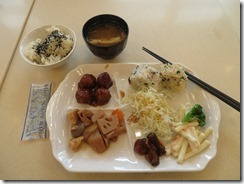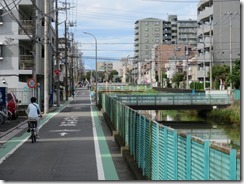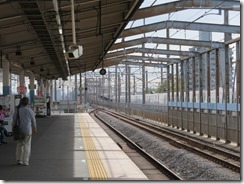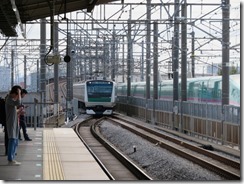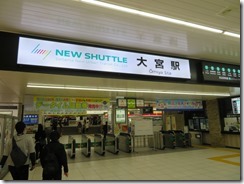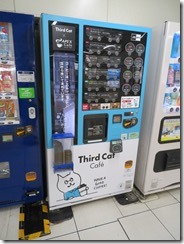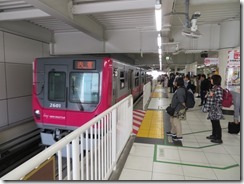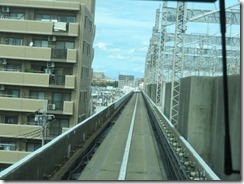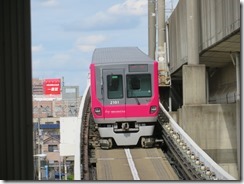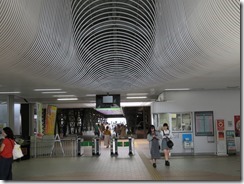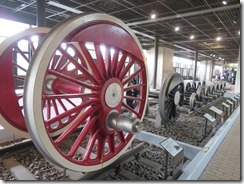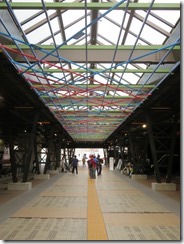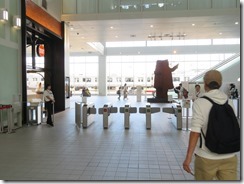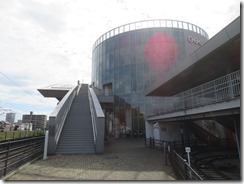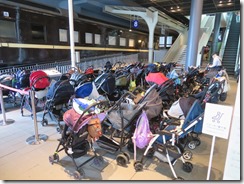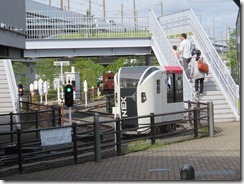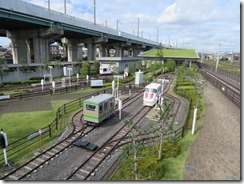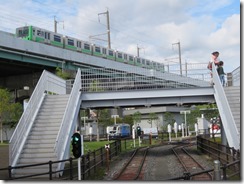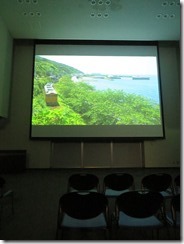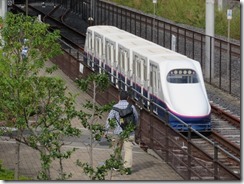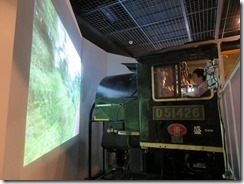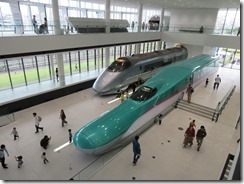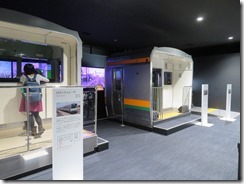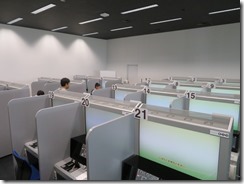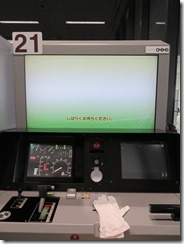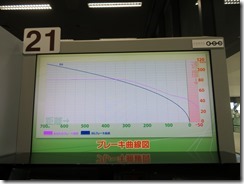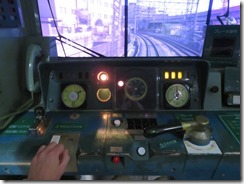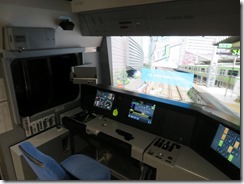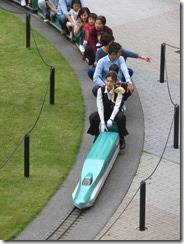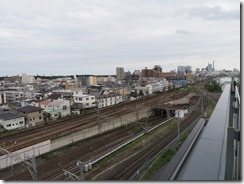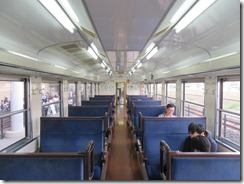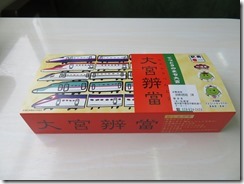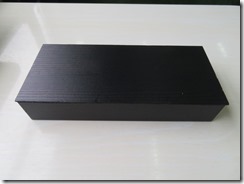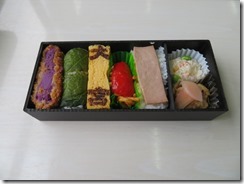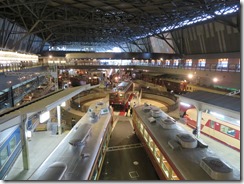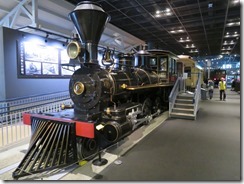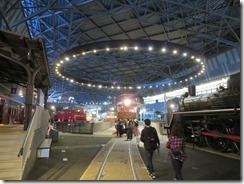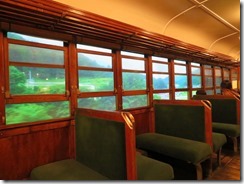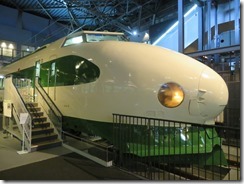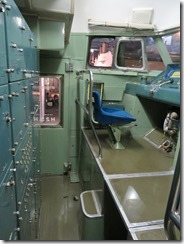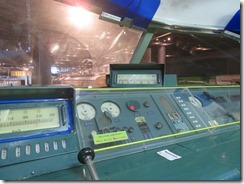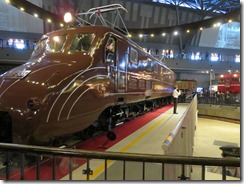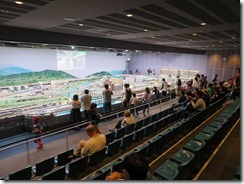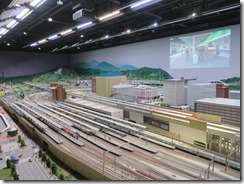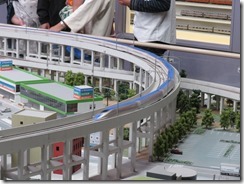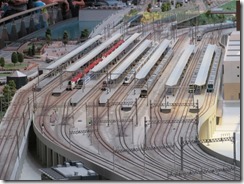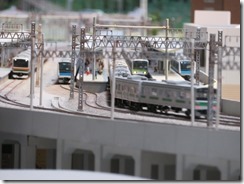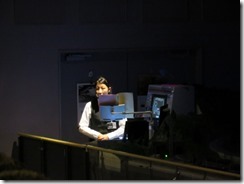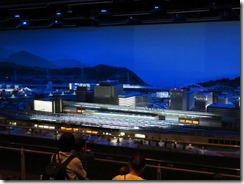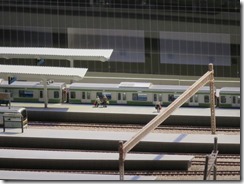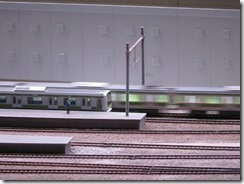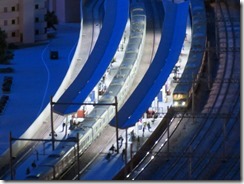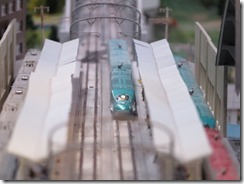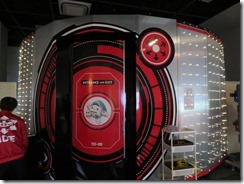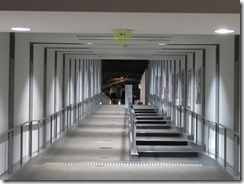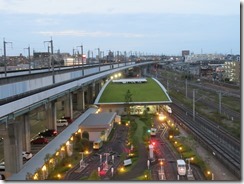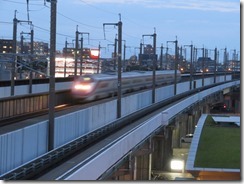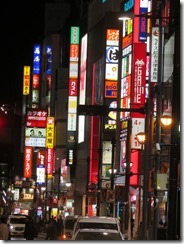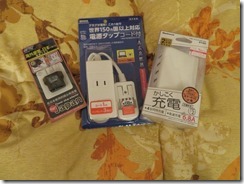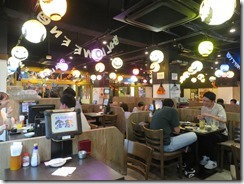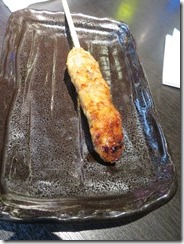Japan has an area less than half that of New South Wales, yet it’s divided into forty-seven prefectures, each of which is roughly equivalent in legislative power to the states of Australia, so far as I understand it. If you omit Hokkaido (the largest prefecture by far), the average size of Japan’s prefectures is only a little larger than the average Local Government Area in NSW. When I imagine local councils in Australia passing laws, it almost makes me wonder how anything gets done…
Just to shake things up a bit, I thought I’d start today with breakfast.
Considering the late night I’d had last night, I decided to take things easy today with a trip to a museum – the Railway Museum in Saitama City (Saitama Prefecture), just north of Omiya Station (actually, it’s located alongside the Shinkansen tracks, so I’ve seen it a few times from the train already). It’s JR East’s museum – JR Central has a museum in Nagoya, while JR West has one in Kyoto. But the plan was to just go there, spend a few hours, come back and have an early night.
The museum’s main exhibit is the huge rolling stock hall, with about 30 railway cars and engines, but it’s also got other things like authentic train driving simulators – for the Tokaido, Keihin-Tohoku and Yamanote Lines, D51 steam locomotive, and E5-class shinkansen – hands-on exhibits of the science behind trains, historical exhibit and future projections, libraries, movie theatres, a huge model train diorama, mini trains you can drive yourself, mini trains to ride, and temporary exhibitions. Not to mention restaurants and cafes. Whew. It’s also got an app, which (unlike the Kawagoe Festival app) is available in English. And one of the things I find clever is that everything in the museum has a coordinate based on how far north or south it is from the main entrance (for example, the Kids Cafe is listed as 1F N110 = on the first floor, 110 metres north of the entrance), and everywhere you go there’s markers on the floor saying what coordinate you’re standing at now.
So, I went. Took the Saikyo Line to Omiya – and actually, this is the first time I’ve actually had to wait for the Saikyo Line train, instead of arriving on the platform to find the train already there. At Omiya, you change to the New Shuttle, a rubber-tyred people mover that runs along the sides of the Shinkansen track (and actually, it’s only a bit over six months newer than I am, having opened in December 1983, so it’s a tiny bit of a misnomer there). It’s a private line, though the operating company is part-owned by JR East, Tobu Railway and the Saitama Government. Unfortunately, in the sense that I wanted to ride it for the fun of it, the museum is only one stop from Omiya.
From Tetsudo Hakubutsukan Station (= Railway Museum Station), it’s just a short walk along a covered concourse to the museum entrance. The concourse itself has a few exhibits – a bunch of different-sized train wheels, a steam train and an electric train you can photograph yourself in front of, and a design in the ceiling that took me a while to figure out – it’s a graph of the train timetable (forward and back is the time axis, left and right is the distance along the track).
At the museum, I bought my ticket – it’s actually a contactless IC card like a Suica, and you enter the museum through ticket gates that look like station gates. Several of the exhibits require reserving a specific timeslot (and, occasionally, an extra payment), and I discovered when I arrived that the mini train driving, D51 simulator and E5 simulator had already been booked out for the day (the other three simulators are free and don’t require reservation, just queuing). Aww. I could probably have arrived sooner, but I wonder if it’s possible to book in advance or something. Today’s Sunday, incidentally, and it’s the museum’s busiest day of the week, according to Google Maps. So yeah. And probably half of the visitors were young kids. Yeah.
I decided to try wandering over to the mini train driving to see if there were still slots available despite the sign at the entrance, but nope. Looks like fun, though.
I strolled along the mini train driving tracks to the Teppaku Hall (“Teppaku” being an abbreviation of Tetsudou Hakubutsukan – the reason it’s -ppa- rather than -tsuha- is due to how gemination works in Japanese) where there’s a kid’s library (including books in English, like The Little Engine That Could) and a theatre showing videos of various trains, but I didn’t stay there long – I hopped on the Teppaku Line, a little hobby train in the shape of a Shinkansen, which took me back to the main building.
At the main building, I headed up to the simulator hall in the south building to see if they still had availability there. I misread a sign, and thought they did still have spaces for the E5 simulator, and quickly put my name down, then went to queue for one of the free simulators. I managed to reach the second place in line before my enrolled time arrived, so I had to leave the line, and go to what I’d enrolled for… which turned out to be the Train Driver Simulator Classroom.
Not what I’d intended to sign up for, but it was quite a bit of fun all the same. It’s a big room filled with twenty-one mini-simulators, you get a pair of cotton gloves similar to what train drivers wear, and they teach you how to actually drive a train, and an overview of the controls. Before pulling out of a station, you need to wait for the light on the console to come on which indicates that the conductor has signalled the train is ready to depart – you need to raise your hand to your (invisible, as it was) hat brim, point at the light, and say “tentou” (“lamp illuminated”), then raise your hand again, point at the green light in front of you and say “shuppatsu shinkou” (“vehicle departing”). Then you can start moving.
More to the point, they also teach you how to stop – the brake has eight power settings and then the emergency setting, but the usual highest level for passenger comfort is B6, but when you’re travelling at 80 kilometres per hour, setting B6 requires 350 metres to stop – they briefly showed a graph of speed versus stopping distance for all of the brake settings, but they showed it far too fast for me to memorise. First, though, they let you try to stop completely unassisted, and then they put your performance on the screen next to the ideal performance, and let you know how badly you did. I… rather badly overshot the first time. On my second attempt, though, after seeing the graph, I managed to get just sixty centimetres from the target position. Nice. I… neglected to take a phot of this for posterity. On the third attempt, they added rain to the simulation, and I rather overestimated how much effect the rain would have, and undershot by a fair amount. The class was all in Japanese, but I largely managed to follow along… I think. May not have quite caught the point of some of the things. Slight downside: occasionally, a touch screen is used to administer test questions, but the screen doesn’t work if you’ve got the gloves on.
Anyway, I think you can tell I enjoyed that. Might have to go back for the intermediate and advanced classes, though I also might need to be able to read faster for that. Then I went back to have a go on the other simulators. The first one I tried was a much older model of train than what I’d trained on, so it took me a little while to get used to the controls. Then I tried the third one in line, the one with the same model as the simulator classroom, and I did pretty well, though wasn’t able to replicate my earlier success – I undershot by five metres, then overshot by five metres.
Then it was time to go and find some lunch. I seriously considered the View Restaurant – it’s on the fourth floor of the south building (uh, I mean, 4F S235) – with a nice view over the shinkansen tracks on one side, and the surface train tracks on the other, but I noticed on the ground floor that they had actual train cars you could sit and eat in, so instead I went to the Ekiben shop and bought an Omiya-specialty bento, and sat in the train cars.
The train cars, they… uh… well, they stank the stink of ancient upholstery, which was really not conducive to enjoying a meal, so the View Restaurant would probably have been a better idea (especially as I’m also planning an ekiben for lunch tomorrow). The ekiben was nice enough, in any case – from left to right, it’s purple sweet potato croquette, mustard greens nigiri, tamagoyaki (with “Omiya” written on it), Napolitan spaghetti with red paprika (a Japanese pasta style, rather than Neapolitan…), sausage-meat nigiri, miso pork, onion corn slaw salad (with edamame), and pickled ginger.
After lunch, it was off to the Rolling Stock hall. Actually, I’d already walked the length of the second-floor balcony about three times, heading back and forth from other things. It’s an absolutely spectacular room. It’s got everything from the very first steam train in Japan up to a Series 200 Shinkansen (the first train to run on the Tohoku Shinkansen), and also the driver’s compartment of a Series 0 Shinkansen (the first train to run on the Tokaido Shinkansen) that you could climb inside (and “climb” is the right word – the drivers’ seats are up two very high steps). I quite liked the old train cars with the wooden floor boards, and there was one car with screens set up outside the windows with video of the countryside going past.
Side note, drawings of the Series 0 and Series 200 Shinkansen are still used on station signage to represent the Tokaido and Tohoku shinkansen lines, even though neither train has been used since 2013. Rather like the way a floppy disk is still used to represent “save” in computer applications…
There’s also a working turntable in the centre of the room which is given a full rotation twice a day for the entertainment of visitors – and the second of those two times just happened to be when I walked in. So I watched that.
Once I’d seen all the trains to my heart’s content, I went upstairs to see the model diorama. It’s quite an expansive diorama, with trains running all over. There’s also a show every now and then – all the guests sit in the seats, while the host operates the lights and trains while narrating… something. Honestly didn’t catch a word of it.
After the show was done, it was 4:30, so I decided to quickly head over to see the Science exhibit, getting distracted on the way by a 360° 3D movie experience about shinkansen trains that turn into robots to battle other shinkansen train robots. Only about five minutes long, and stuff that was too close in the foreground just made my eyes water, but it wasn’t bad. Not entirely sure it was worth the ticket price, mind. Actually, it was 4D, because they blast air at you every time a missile or shrapnel or whatnot goes past, which was a shade disconcerting.
Finally reached the Science exhibit. Much science was done. There’s displays on why train wheels are shaped the way they are, why they’re made of metal, while upstairs there were displays about automatic signalling and regenerative breaking and so forth, and… I don’t seem to have taken any photographs here. I could have sworn…
Quickly popped outside to see the Panorama Deck, which had a view of the Shinkansen tracks, and also a timetable so that you’d know precisely when trains would be passing by, but by now the sun was already setting. Or had set. After one more whip around for a couple more photos, I headed out. And it just now occurred to me that I clean forgot to visit the ground floor of the south building at all (which had exhibits about the various jobs that go into running a train, like ticket sellers, conductors, emergency repair crews, and so forth).
Hopped back onto the New Shuttle – I briefly considered going a few stops the other way for the fun of it, but it was dark, so I wouldn’t have been able to see much. Instead, I headed back to Omiya. At Omiya, I went the nearby Bic Camera to buy a few things to make up for the loss of my power board (I e-mailed the hotel about it, but I never received a response, and the phone number that I have for them just gets a “no such number” error) – bought a Japanese power strip (which actually turned out to be intended for travellers – it’s got multiple plugs – and which I’ve just noticed has a label on the side saying “NOT FOR JAPAN”) to make up for lack of plugs, an Australian-to-Japanese converter (quite surprised to find that, actually), and a Japanese four-port USB charging hub (so I can charge all my USB stuff without using any adaptors). That cost rather more than I would have liked, especially considering I can get a new board for pocket change in Australia, but it’s better than managing without most of my electronics for the next week.
Then it was time to go find somewhere for dinner, while simultaneously having our regular video chat with the family. I eventually wound up eating at a place that basically did bar food – I got beef-and-cheese meatball on a stick (I was actually expecting two sticks, but only one arrived), half a loaf of fried tofu, and fried chicken with cheese. That… actually cost a fair bit more than I’d expected, considering each individual item wasn’t all that expensive, though there was also some sort of cover charge on the bill as well. Ordered via iPad too, which was nice.
I still can’t get over the fact that Japan has this chain of stores that only sell snack foods and lollies. Like, there’s even a stack of shopping baskets outside, so it’s not just a “grab a bag of chips” thing, it’s a “fill a whole basket” thing. And business people were going in there, on the way home from… work? Wait, it’s Sunday…
Then it was back home to Toda-koen. The knee that I banged on the stone pillar yesterday wasn’t at all painful today, but when I took my trousers off this evening, I discovered much of it was turning dark purple. Doesn’t hurt at all, though.
Today’s photo count: five hundred and fifty. Also rolled over the next ten-thousand photo tick on the camera. Think that makes ninety thousand photos… I think. That seems like a lot. Can’t remember if the count of ten-thousands started at zero or one, and perhaps some numbers got prematurely ended by camera setting tweaks.
Today’s pedometer count: 15,538 steps – 10.9 kilometres – 20 flights of stairs
Todays stamp count: Three – the New Shuttle Tetsudou Hakubutsukan Station, one at the Railway Museum (which I also stamped in the space provided on the back of the museum map and a souvenir ticket-like thing), and another one at the museum with the E5-model Shinkansen robot on it. The New Shuttle Omiya Station doesn’t have a stamp. Aww.

